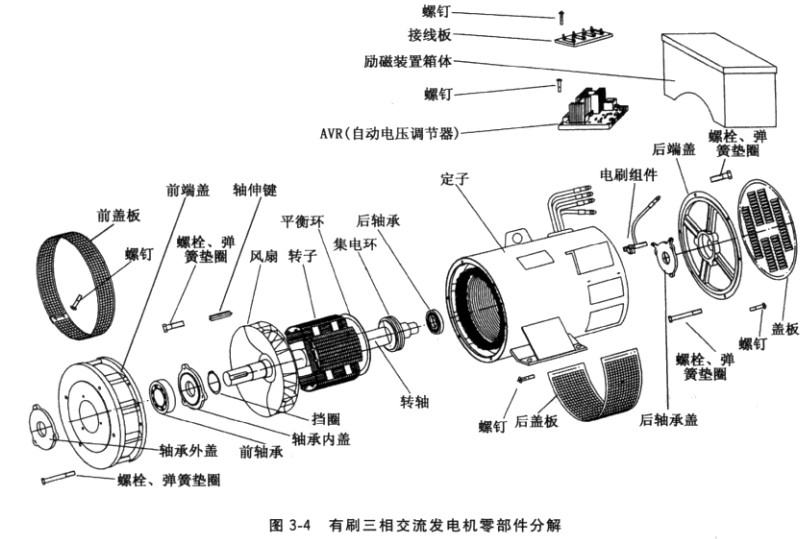Basic structure The generator is based on the basic structure of the brushed three-phase alternator shown in Figure 3-4 , and is equipped with a reactive phase shift excitation device (see Figure 3-17) , which includes a linear reactance with an adjustable air gap. , compound excitation converter, three-phase rectifier bridge group, adjustable varistor and overvoltage resistance and capacitance protection components. (1) Linear reactor. The core of the mountain-shaped punching piece, the upper yoke core, the winding and the air gap insulation are stacked. (2) Compound excitation converter. The core, the primary winding and the secondary winding are formed by a stack of mountain-shaped punching pieces and a flat-shaped punching piece. (3) Three-phase rectifier bridge group. It is a three-phase bridge assembly and can also be assembled from six silicon rectifier components. The output current level of the rectifier bridge group should be greater than 3 to 4 times the rated excitation current of the generator rotor. (4) Magnetic field varistor. Used to shunt the generator excitation current to set the generator terminal voltage. 2. Working principle The principle circuit of the uncontrollable reactance phase shifting phase compound excitation three-phase alternator is shown in Figure 3-18. The linear reactor is connected to the generator stator three-phase winding taps U1, V1, W1. It can be seen from the figure that the voltage component of the AC side excitation current is supplied by the stator winding tap voltage through the linear reactor, and the generator load current is supplied by the compound excitation current to the current component of the AC side excitation current, and the two are geometrically synthesized through the rectifier bridge. After the group is rectified, the excitation current is supplied to the rotor winding of the generator to establish the main magnetic field of the rotor. The function of the linear reactor is to make the phase of the current component supplied by it to be shifted by about 90 electrical degrees, and this current component is supplied to the excitation current required to maintain a certain terminal voltage when the generator is idling. Compound excitation effect of the converter is the phase of the load current phase of the current supplied by the generator points that the same phase, which current value and a negative linear relationship between plant, which is provided by the armature reaction demagnetization when the compensated load The excitation current required for the effect. For departments and places with high precision voltage requirements, a shunt controllable (automatic) voltage regulator can be configured on the basis of uncontrollable reactance phase shifting phase compound excitation. Rotary Tiller,Cultivators Rotary Tiller,Tractor Rotary Tiller,Agriculture Rotary Tiller JINING TIANDE ENGINEERING MACHINERY CO.,LTD , https://www.tdgoldargo.com


Basic structure and working principle of reactive phase shift phase-complex three-phase alternator
Basic structure and working principle of reactive phase shift phase-complex three-phase alternator diesel generator | diesel generator price / 2018-09-21
Previous: Basic mechanism and working principle of brushless three-phase alternator